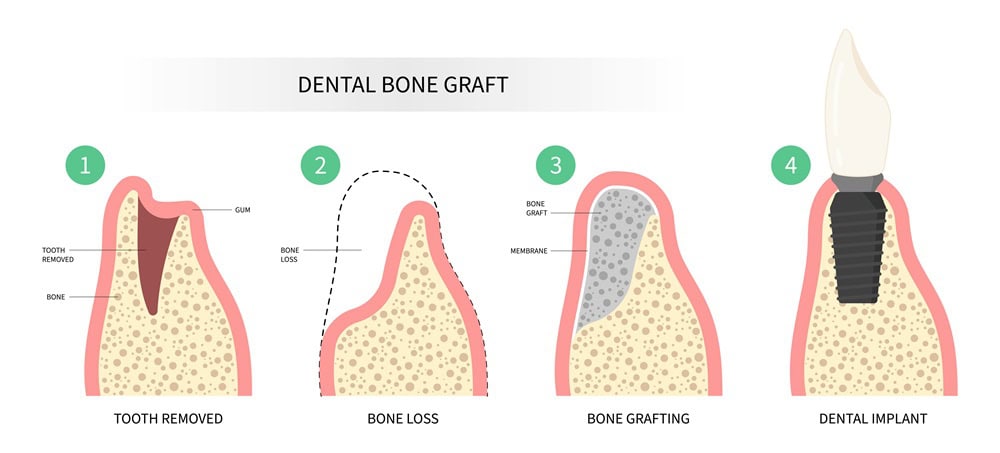Would you like a nicer smile and mouth? Dentures might be the solution. Making that choice is enormous, yet it could have a positive impact on people’s lives. Still, a crucial but often overlooked issue is the quantity of bone in your jaw.
What occurs if your bone density is insufficient for dentures? Insufficient jawbone material can cause more problems than solutions.
If this is something you want to address, the best place to get started is by scheduling an appointment with a dentist in Prince Albert. They can examine your oral structures and take specific X-rays that will help them determine if this is the best option for you and, if so, where to go from there.
What is a Bone Graft for Teeth?
Bone grafting for teeth is a relatively straightforward dental procedure despite its seemingly involved name. Building a strong foundation for your teeth is the most important step. If you’ve lost a tooth or several teeth, your jawbone may have shrunk or deteriorated. When considering dental implants or dentures, bone loss is a potential stumbling block.
A bone graft involves taking a small amount of bone from one area of your body or using a synthetic bone material. This bone is then strategically placed where you’ve experienced bone loss. Over time, your body fuses with the grafted bone, creating a sturdy and reliable foundation for dental procedures like implants or dentures.
This treatment is done to rebuild the support structure for your teeth, ensuring that your smile looks great and functions perfectly. It’s a common and highly effective procedure in modern dentistry, providing a solution for those with bone loss so you can confidently reclaim your beautiful smile.
What Happens During Bone Grafting?
Bone grafting is a common dental surgery to restore bone tissue and strengthen the jaw. Typically, it goes like this:
- Assessment: Consultation begins with a detailed discussion with your dentist or oral surgeon. We will examine your mouth, listen to your concerns, and develop an approach for your bone graft.
- Anesthesia: To ensure comfort, the surgery is carried out under local or general anesthesia. As a result, you won’t feel anything as the surgeon works on you.
- Tissue Sample: Your dentist will collect the bone tissue needed for the procedure. One’s body, that of a donor, an animal, or a synthetic substance are all viable options. Your specific situation and goals should guide your decision.
- Graft Placement: The chosen bone material is then strategically inserted at the site of your jawbone where bone loss has occurred. Your doctor will put it where it needs to be.
- Healing: Over time, your body works its magic. It gradually merges with the grafted bone, a process known as osseointegration. This process can take a few months but is crucial for a solid base.
- Follow-up: You’ll have regular follow-up appointments to monitor your healing progress after the procedure. The dentist will evaluate the graft’s growth while fusing it with your jawbone.
The jawbone has been renewed and strengthened, making it suitable for dental implants, dentures, or other restorative procedures. Bone grafting is a crucial procedure for achieving a beautiful, healthy smile.
What to Expect After Dental Bone Grafting
It’s common to have concerns regarding the healing process following dental bone transplantation. Here’s what you should expect in terms of attentiveness and accessibility:
- Immediate Recovery: Feeling slightly uncomfortable and swelling in the hours after the treatment is normal. Your dentist will give you specific recommendations on how to deal with the discomfort.
- Oral Hygiene: Good dental hygiene is essential for preventing illnesses. You’ll want to hold off on brushing the graft for a while. The dentist will give you detailed care instructions.
- Dietary Modifications: To minimize stress on the graft site, follow a soft diet for a few days.
- Follow-Up Appointments: To monitor the healing process, your dentist will schedule follow-up visits with you. They will check to see if the transplant is fusing with your jawbone.
- Full Recovery: The graft will eventually join with your natural bone, which can take a few months. Having patience is essential for success.
Remember that your dentist will provide specific advice and guidance to help you heal quickly and easily.
Prairie Pines Dental: Your Path to a Healthier Smile
Our team here at our neighborhood dental practice is dedicated to your dental health and will support you throughout this journey. We provide comprehensive dental care, from routine cleanings and exams to bone grafting necessary to acquire dentures near you.
Please make an appointment with one of our dentists today; you can contact us by phoning or emailing us. See you soon!
